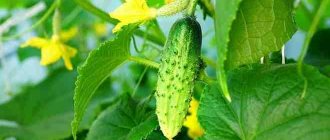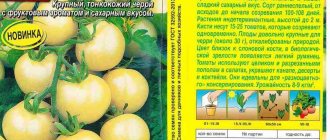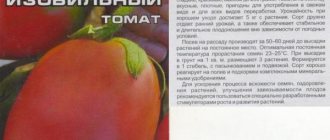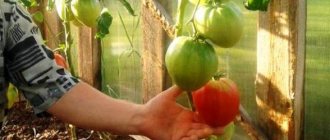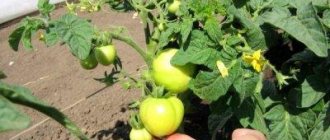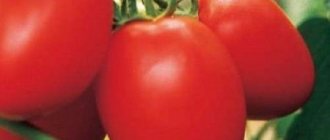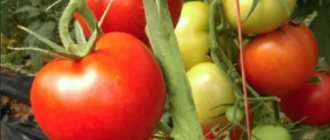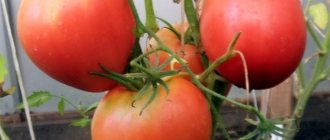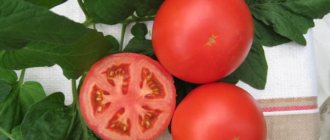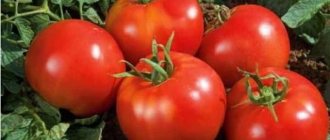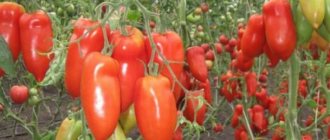General information about the variety
Russian breeders developed tomatoes for cultivation in open ground, film shelters and greenhouses. The location of cultivation depends on climatic conditions.
Characteristics of the plant and description of the appearance of the variety:
- early ripening, up to 115 days pass before the fruit is harvested;
- determinant;
- bush height up to 75 centimeters;
- simple inflorescence;
- medium-sized, green foliage;
- simple inflorescence;
- the stalk has an articulation;
- average fruit size;
- average yield, up to 6 kilograms per square meter of planting;
- resistance to many nightshade diseases - Alternaria and tobacco mosaic;
- transportation of fruits over long distances is permissible;
- there is a possibility of long-term storage.
When grown on an industrial scale, up to 45 tons of fruit are collected from one hectare of planting. The berry is distinguished by the following characteristics:
- cylindrical round shape;
- red color;
- smooth;
- dense;
- has 3–4 nests;
- aromatic;
- thin skin;
- no tendency to crack;
- weight does not exceed 100 grams;
- sweet taste, with sourness.
Consumer reviews indicate the possibility of universal use of fruits. The berry is added as an ingredient to vegetable salads, preparations, pickles and twists.
The best varieties of tomatoes for 2021: photos and descriptions
When choosing tomatoes for their plot, gardeners, first of all, rely on varietal or hybrid characteristics. Productivity is the most important criterion on which the quantity and quality of the harvest depends. Sometimes it can be difficult to choose the right option from the rich variety of tomatoes for open ground and greenhouses. Then varieties are selected depending on the growing region, ripening period, degree of disease resistance and other factors.
Varieties for open ground
A huge number of species with excellent yields are intended for growing vegetables in the open air. Low-growing bushes with large fruits are one of the advantages of tomatoes for the soil. Such heat-loving plants are easier to care for and do not require complex agricultural practices.
According to ripening period
Tomatoes, like other vegetable crops, are characterized by different ripening periods, from early to late.
| Ripening period | Ripening of fruits after the appearance of the first shoots | general characteristics | The most productive tomatoes (2020) |
| Ultra-early ripening | On day 80-85 | The fruits are small, juicy, and low in sugar. The height of the bush is no more than 50 cm. Not suitable for preservation. | Little Red Riding Hood, Pride of Russia, Benito, Superstar, Valentina, Marisha, Maksimka |
| Early ripening | For 90-95 days | Small, delicate fruits, average yield. Suitable for canning and salads. Bushes grow up to 70 cm | Agatha, Riddle, Augustine, Lyana, Sanka, Buyan, Lakomka, Amur standard, Grandmother's kiss |
| Mid-early | On days 100-103 | The fruits are juicy, small, aromatic. The purpose is universal. Bush shape - compact | Openwork, Babushkino, Pulka, Red Giant, Russian Soul, Cardinal, Flamingo |
| Mid-season | On day 100-115 | High taste, excellent yield. There are both low-growing and tall varieties | Scarlet Candles, Hybrid Basket, Stresa, Intuition, Black Baron, Pudovik, Pink Honey |
| Late ripening | On day 120-130 | Excellent fruit taste, high yield, universal purpose. Good keeping quality and transportability of fruits | Giraffe, Cosmonaut Volkov, Titan, Rio Grande, Russian size, King of Kings, Rocket, Premier |
The ripening time, color and shape of tomatoes depends on the variety.
Usually early-ripening vegetables with not large fruits and not a large harvest, but with a quick, friendly yield of ripe tomatoes. Mid-season ones also have medium sizes. Late ones are usually difficult to care for, but it is among them that you can find champions in weight, but there are not many such beauties on the bush.
By growing region
Every year, breeders create new species with high quality indicators. In stores you can buy specialized varieties of tomatoes designed for growing in certain climatic conditions. Classification by regions of Russia:
- for the Moscow region: Champion, Sweet Bunch, Honey, Pink Elephant, Fireworks, Bull's forehead;
- for the southern regions: Torch, Novice, Titan, Winner, Bison, Ermak, Gift, Mikado;
- for the middle zone: Bull's Heart, Black Prince, Uzbek (Yusupov), Moskvichka, Snowdrop, Big Brother, Spasskaya Tower;
- for Siberia: Siberian heavyweight, Ultra early ripening, Sanka, Abakan pink;
- for the Urals: Coin, Bull's Heart, Button, Countryman, Yellow Buyan, Bullfinch, Demidov;
- for the far north: Snowy Tale, Ballerina, Ladyfingers, Berdsky Large, Countryman, Oak, Gina.
An unpredictable, cold or, conversely, excessively warm climate is not a reason to refuse to grow tomatoes in open ground. Thanks to selection, varieties have been developed that grow and develop well in any terrain.
According to disease resistance
To obtain a rich harvest, you need to choose tomato varieties not only with the appropriate characteristics. It is necessary that this criterion be supplemented by such an indicator as disease resistance.
Late blight, root rot, tobacco mosaic, cladosporiosis are diseases that most often affect plantings of heat-loving crops.
A catalog of tomatoes that can withstand the onslaught of various diseases:
- Blitz;
- Koenigsberg;
- Geisha;
- Betta,
- Anyuta;
- Bohemia;
- Chio-chio-san;
- Tatiana;
- Puzata hut;
- Lights of Moscow;
- Yablonka Russia;
- Crimson giant.
Unfortunately, there are no varieties that are 100% resistant to infections. But there are hybrids that produce a harvest until the active phase of many fungal diseases and infections begins.
Varieties for greenhouse cultivation
Having a good greenhouse at your disposal, you can get fresh tomatoes to your table all year round. Greenhouse varieties are suitable for preparing salads or canning. Excellent salad tomatoes can be obtained from the following varieties:
- Geisha;
- Fairy gift;
- Andromeda;
- Eagle beak;
- Pink Angel;
- Pink Pearl;
- Fatalist;
- Scarlet caravel;
- Amana orange
The best varieties for preservation:
- Auria;
- Banana legs;
- Pink raisins;
- Rajah;
- Baba;
- Alexander the Great.
Cherries are sweet, small tomatoes that grow well both outdoors and in a greenhouse, but small-fruited vegetables tend to be more productive in protected beds. Magic Harp F1 and Yellow Caramel F1 are hybrids whose fruit weight does not exceed 25 g.
When choosing a vegetable for a greenhouse, many rightly give preference to tall and high-yielding varieties. But low-growing plants, which usually have an early ripening period, as well as mid-ripening tomatoes, are also excellent for polycarbonate shelters in all regions of Russia.
Description and photos of the best hybrids
For open ground, breeders also offer species with high yields of hybrid origin; they are resistant to diseases and temperature changes. The best tomato varieties of 2020:
Growing Tips
The heat-loving plant prefers the seedling method of planting. It is advisable to begin work on sowing seeds in mid-March. Healthy seedlings require compliance with a number of rules:
- mandatory maintenance of temperature conditions not lower than 22 degrees;
- use warm water for irrigation, spray irrigation before emergence;
- the first shoots should receive a sufficient amount of ultraviolet radiation, the duration of daylight should be at least 16 hours;
- preliminary hardening before planting.
IMPORTANT! The best yield is achieved when the tomato is formed into 1–2 stems.
The originator advises planting tomatoes in a greenhouse or open ground in mid-May. For planting, you should use a pattern of 60 by 30–40 centimeters; there should be no more than five tomatoes per square meter of land.
Features of growing cocktail tomatoes
- The skin of most cocktail tomatoes is dense; overwatering is not as bad for them as for cherry tomatoes.
- Ripening is more or less consistent, but tomatoes at the ends of the clusters ripen longer.
Rice. 1 Ampel tomatoes. Photo by gulnara15
- Weight – from 30 to 60 g (and a little more). The shape of tomatoes is round, pear-shaped, plum-shaped or teardrop-shaped.
- Indets can be formed into 1-2 stems in a greenhouse or 2-3 stems in a greenhouse.
- In mid-August we pinch off the top of the main stem, leaving only a couple of leaves at the top. We do not cut off the determinants.
- Some cocktail tomatoes require frequent pinching, especially indets.
- Where to grow cocktail tomatoes is up to you. They grow equally well both in protected soil and outdoors.
Gardeners' opinion
Good day to all! For tomato lovers, I recommend sowing a Matador tomato. The variety is very unpretentious, the bush is compact, the yield is decent. The fruits are small in size, the weight of individual fruits does not exceed 100 grams. The berry is ideal for whole-fruit pickling and drying. Sweet in taste, it is great for fresh salads. The harvest can be harvested in early August.
Good afternoon! Last summer I tried to plant Matador tomatoes. The plant withstood the cool summer and showed good productivity. Loves feeding and abundant watering. In greenhouse conditions, it is imperative to regularly ventilate the room. Resistant to nightshade diseases. I liked the variety. The ripe berry is small in size and has a good taste. I recommend!
II. Indeterminate varieties (unlimited growth)
These are tomatoes that will grow until they turn blue until the owner or the onset of the cold season stops them. They have great yield potential, which is more successfully realized in high greenhouses. We place approximately three bushes on 1 square. With supports such as strong trellises, open ground is not prohibited, which will be especially welcome in the southern regions.
Tomato Scarlet candles
Good for pickling, sweet. This is a patented mid-early variety (Siberian breeders distinguished themselves!). In the state register since 2007. They are characterized by a high ability to form ovaries in any conditions. From 1 sq.m you can actually get a bucket and a half. The clusters are arranged in tiers, the weight of the fruit on the lower branches reaches 120 g, on the top ones - half as much.
Very lightweight. A mid-early Siberian variety for canning whole vegetables. The fruits are elongated, reaching (maximum in our conditions) 13-14 cm in length, weighing about 120 g, and have a beautiful crimson hue. They have few seeds, are very fleshy, strong, and easy to keep. If they are picked green, they do not spoil and ripen perfectly.
The longest
A new product of Siberian selection. It begins to ripen already on the 110th (you can add a couple more) days from the sprouts appearing on the surface of the soil. Fruits have a unique length - 20 cm (specific size)! They are very elongated, with a small pear-shaped constriction in the upper part, uniformly slightly expanding downwards, with a spout. Vegetable clusters bear up to seven red fruits weighing up to 180-190 g. The product is successful in transportation, long-term storage, and pickling. Collection - at least a bucket from three plants.
High yield
The variety is productive and unpretentious. Tolerates slight shading. It ties well. Neither high nor low temperatures are scary. It succeeds in protected soil, but outdoor cultivation is not prohibited. Tomatoes begin to ripen in 106-113 days; at the same time, the plant successfully continues to grow and form clusters - up to 10 pieces per bush.
Each bears up to eight graceful fruits - cylindrical and pointed, in full ripeness - iridescent pink in color. The weight of each vegetable is 100-120 g. They contain a high percentage of sugars and dry matter. They do not burst when pickled, are good for drying, obtaining thick juice and, oddly enough in your opinion, for making tomato jam. With diligent care, the bush can bear up to a bucket of quality fruit.
Tomato Niagara
Weighty brushes
This mid-early vegetable variety has been on the state register since 2010. The bush is tall, but compact in width. It has a highly branched root system, responsive to increased nutrition and good water supply. A valuable feature of this Siberian variety is its multiple clusters, each of which bears up to 14 fruits weighing 85-115 g.
Meaty and sweet
This is one of the sweetest and meatiest products of Siberian breeders. It has been registered in the state register since 2007. The tomato is mid-season (116-118 days from the appearance of sprouts), with large foliage. The fruits resemble long, sharp peppers - they grow up to 15 cm. They are an elegant red color, the weight ranges from 120-185 g. The pulp of vegetables contains very little water and seeds. In the best case, there are up to a dozen fruits in one cluster. One bush gives 2-3 kg.
Tomato Koenigsberg
Excellent ovary
Included in the state register in 2005. The variety rightfully takes its place among the most productive Siberian varieties (up to 20 kg per square meter of land in a greenhouse). It sets perfectly even in the hot atmosphere of closed ground. Plants with a powerful bush with large leaves require increased nutrition and careful pinching.
The first ovary is formed after the growth of the 12th leaf, then inflorescences are formed every 3 leaves. Refers to varieties of medium ripening; in Siberian conditions, approximately half of the crop ripens; the rest of the fruits turn red quite well when ripened. Tomatoes in the lower clusters of vegetables weigh 300 g, and in those above - no less than 150 g. The shape is elongated, heart-shaped, smooth, and beautiful.
Vitamin and sweet
Ripe tomatoes have a golden-orange color and contain a record amount of carotene vitamins. The pulp is sweet and aromatic, like berries and fruits. The ripening period is average. The lower fruits are capable of filling up to a mass of 400-450 g, higher up the bush - 200-300 g. They are oval, often with a spout. The plants grow clusters through the leaves, each containing on average, as stated, up to 5 fruits. Productivity is high. The keeping quality is excellent. It is especially tasty when salted with gelatin.
Harvest hearts
Close internodes and a powerful trunk with dense foliage are like standard varieties, only the height is two meters. The Siberian breeding novelty produces half a bucket of fruit from one such “tree”. Ripening begins on the 115th day. Forms up to 6 beautiful clusters with 5-7 red tomatoes weighing 200-250 grams, shaped like strawberries.
Tomato Budenovka
Resistant to cracking
The variety is an improved version of Ox Heart, with a higher yield (about 9.4 kg per square), early ripening, good resistance to diseases (even to late blight) and cracking of the apical tissue of the fruit for a fleshy variety. Heart-shaped, ribbed tomatoes with excellent taste.
Record weight
The variety is a new product from a team of breeding scientists under the leadership of V.F. Gavrisha. Registered in the state register in 2015. Due to the unrealistically large fruits of vegetables, it is included in the “Russian Hero” series. The variety is not very fast in terms of ripening time (from 120 days), therefore it requires early planting of seedlings, especially careful pinching and decent feeding.
In Siberia and Central Russia it works well only in closed ground conditions, including a greenhouse. The average return from a bush is 3.6 (plus or minus) kg, the record is 7 kg. The tomatoes are flat-round, slightly ribbed, have an excellent smell and are very juicy, each weighing 400-600 g, not uncommon - 800 g. There are 2-3 tomatoes in one cluster of plants; if you leave only one tomato in it, it can pull more than 1 kg. Such “bogatyrs” are better suited for salads and distillation for juice.
Bowl of salad from one fruit
One of the best salad novelties, the yield is high. The plant bears 5-6 racemes. The fruits look very attractive due to their raspberry-pink color, large up to 500-800 g. The tomatoes are flat-round, ribbed, sweet. There is high resistance to cracking; The pulp density is average. A rare quality for large-fruited varieties: the fruits do not tend to quickly soften and spoil during storage.
According to the ripening period, the variety is classified as mid-early and mid-ripe. Perfect for preparing preparations: tomato paste, juice. This tomato variety is characterized by high yield. You can remove up to 5-6 kilograms of tomatoes from one bush.
Giant orange sweet
It has plasticity, rare for a large-fruited variety, and relative unpretentiousness. Delicate sweet pulp combines with excellent keeping quality. The tomatoes are round-flat (their “ribs” stand out a little), sunny orange in color. The average weight of a tomato is 0.5 kg, but in reality there are 1 kg of fruit on the bush.
Some information about the Toreador tomato
It belongs to the early ripening varieties. This is facilitated by the rapid germination of seeds, resistance to frost on the soil, and a small mass of fruits. Bred by specialists from the Semko Yunosha company, he was immediately appreciated by amateurs and professionals. In the opinion of experienced gardeners, this variety should definitely be planted in a summer cottage, because it is unpretentious, ripens early, and already in the first days of Gutya you can find several fruits on the bushes and make a fragrant, vitamin-rich salad.
The plant reaches a height of 75 cm, which is ideal for central Russia, where squally winds often sweep through, breaking even tall plantings, even if they are tied up in time. The matador does nothing more than crouch to the ground, waiting out the storm. Flexible and at the same time strong plants phlegmatically tolerate climatic surprises. A developed root system allows you to collect and enrich moisture without requiring frequent watering.
It is grown through seedlings and sowing in clear soil.
Important:
recommended by the State Register for cultivation in private household plots, which confirms the excellent numbers of the variety and its high yield.
4-7 clusters are formed on the bushes after 4-5 ovaries in each. As a result, the yield approaches 6 kg. from 1 sq.m. Pomona gifts reach 100 grams, are smooth in appearance, cylindrical in body, bright red when ripe, with dense pulp and thin skin. The exception of the variety is the universal use of fruits, the absence of a tendency to cracking, and a long shelf life.
In order to obtain an earlier harvest, they are grown in greenhouses through seedlings. The timing of planting in wide open ground is adjusted in accordance with the climatic characteristics of the region.
Description of the Lagidny tomato variety, its characteristics
Each tomato variety has its own purpose. Thus, many summer residents choose the Lagidny tomato for preserving whole fruits. The specifics of growing this vegetable crop are not difficult; to get a successful harvest, it will be enough to know a few nuances of agrotechnical work.
Features of the variety
The Lagidny tomato variety was obtained by Kyiv breeders at the horticultural experimental station of the Ukrainian Research Institute. Since 1993, the variety has been approved for cultivation in the Far Eastern regions, the Central Black Earth region and the Middle Volga region. The tomato is recommended for growing in open ground and in greenhouse conditions.
Variety characteristics:
- Lagidny tomato is an early ripening crop. The growing season from seed germination to full ripening of the fruit is 110–120 days.
- The plant is high-yielding. Number of fruits per 1 sq. m. is more than 9 kg.
- The bush is non-standard, determinate, 50–60 cm high.
- The leaves are simple, medium in size, dark green in color.
- The first raceme is once branched, with 4–5 fruits, tied above the 6th leaf, followed by a periodicity of 1–2 leaves.
- The root system coming from the stem is well developed.
A special feature of the variety is the quality of the fruits, which can be consumed both fresh and processed.
Description of fruits
The Lagidny variety has gained particular popularity in fruit and vegetable growing for the taste of its fruits, which are endowed with a high sugar content. The appearance and strength of the skin allow you not only to get a tasty, beautiful summer salad, but also whole-fruit canned tomatoes. The fruits are also used in the preparation of sauces, pastes and other winter dishes.
Description of the tomato at the transportability stage:
- weight – 50–90 grams;
- shape – plum-shaped;
- color – bright red;
- pulp – fleshy;
- taste qualities are high.
According to reviews from gardeners, the fruits of the Lagidny variety tolerate transportation well, maintaining their appearance during long-distance transportation.
Advantages and disadvantages of the variety
Like all fruit crops, the Lagidny tomato has its pros and cons when growing. Therefore, before purchasing seeds, you should familiarize yourself with its advantages and disadvantages in advance.
Advantages of the variety:
- friendly ripening of tomatoes;
- fruit resistance to cracking;
- good yield even in unfavorable years;
- high transportability qualities;
- ease of care.
The variety is also endowed with good immunity to bacterial spot.
Disadvantages of the variety:
- poor resistance to late blight;
- susceptibility to septoria;
- frequent damage by macrosporiosis.
In addition, for good yield, tomato requires fertile soil and timely agricultural technology.
Agricultural technology
The Lagidny variety can be grown by seedlings in open ground or by sowing seeds in greenhouses. The main component of agricultural technology is the processing of seed material.
Important. Before planting seeds, it is recommended to treat them with a solution of potassium permanganate and then rinse them with warm water.
In this case, it will be possible to increase the germination of planting material and neutralize it from fungal infections.
After germination of seedlings, the following agricultural techniques are carried out:
- At the stage of formation of 2 true leaves, picking is carried out.
- Plants are planted according to the scheme - 30x70 cm.
- During the period from seed germination to the appearance of the first inflorescences, fertilizing with complex fertilizers is applied 3 times.
- All side shoots of the bush are removed before the first cluster appears.
- It is recommended to regularly shoot tomatoes, forming a plant with one stem.
- Despite its short stature, the bush is tied to a support or trellis.
Watering, weeding, loosening and disease prevention are carried out in a standard way as needed.
The best predecessors for Lagidny tomatoes are: carrots, cucumbers, onions and legumes. According to the recommendations of experienced specialists, for good pollination it is necessary to attract insects. To do this, the plant will need to be sprayed with a sugar solution prepared from: 1 liter of water, 100 grams of sugar and 2 grams of boric acid.
By following these simple expert tips and the above agricultural techniques, even a beginner in fruit and vegetable growing will receive a decent yield of tasty tomatoes for whole-fruit canning.
Advantages of the Matador variety
The breeders included in the initial qualities:
- performance;
- disease resistance;
- ease of care;
- high productivity;
- excellent taste;
- friendly harvesting;
- possibility of long-term storage and transportation without loss of presentation;
- comprehensiveness of product use.
According to reviews, they completed the task magnificently. A pleasant bonus was the opportunity to collect mora for the next year in the conditions of a summer cottage. The Matador tomato is a variety, but an illiterate hybrid, which means it does not lose its original characteristics. Housewives really liked the neat, small, smooth fruits, which showed excellent results in twists, pickles, making juice, adjika, lecho, and complex multi-ingredient sauces. Amazing for those new to gardening.
Tomatoes: how to choose the right variety
The taste, shape and color of the fruit skin play an important role when choosing tomatoes for your garden. As a rule, experienced gardeners pay attention to the size of the bush, the manifestation of determinacy and the timing of ripening. Beginners in this business most often strive to grow fruitful tomatoes in their beds, but the ideal situation is when quality and quantity are balanced. There are certain varietal criteria by which seed material is selected for outdoor tomato beds:
- ripening period: early - ripening 80–90 days after sowing;
- mid-season - their growing season ranges from 100–120 days;
- late - ripen 120–140 days after planting the seeds;
- determinate - tomatoes with limited branching (most often early and mid-season varieties);
- tall - more than 1.5 m;
The color and shape of the fruit sometimes influence the choice of seeds no less: tomatoes with light skin are ideal for allergy sufferers, and small-fruited cherry tomatoes are often grown for baby food and serving salads
It is best to sow early and mid-ripening low-growing tomatoes for seedlings in open ground. And also, according to experts, determinate and semi-determinant soil tomatoes have the highest returns. Late-ripening cultivars are most often planted in order to extend the harvest period - these tomatoes are enjoyed even in September, and they can be ripened in a cool room after picking.
Tomato Matador - description and characteristics of the variety
To get a good harvest over large areas under private plot conditions, it is necessary that the variety takes root well, is resistant to diseases, has high yields and can withstand transportation. Both summer residents and agricultural producers speak highly of the Matador tomato. Breeders managed to develop a surprisingly unpretentious species that grows well in any climatic conditions, except those extreme for nightshades.
Some information about the Matador tomato
It belongs to the early ripening varieties. This is facilitated by the rapid germination of seeds, resistance to frost on the soil, and the small mass of fruits. Bred by Semco Junior specialists, he was immediately appreciated by amateurs and professionals. According to experienced gardeners, this variety must be present in the summer cottage, because it is unpretentious, ripens early, and already in early August you can find several fruits on the bushes and make a fragrant, vitamin-rich salad.
Planting and care
The plant is low, with a powerful horse system, which must be taken into account when sowing. Before planting, the seeds are soaked in a weak solution of manganese, then placed in peat cups or boxes with soil mixture to a depth of 2 cm, slightly moistened, covered with glass or film. During germination, seeds are demanding on temperature; it should not fall below +22. After the shoots emerge, the film is removed.
The best ratio for sowing seeds:
- loam;
- sawdust;
- peat;
- humus in equal proportions.
The bush is formed into 2 trunks, one main, the second from the lower stepson. The remaining shoots are promptly removed. Watering is carried out 1 - 2 times a week at a rate of 4 - 5 liters per plant.
Please note: the ideal watering option would be a drip irrigation system that prevents moisture from getting on the leaves. To increase productivity, regular fertilizing with organic and mineral fertilizers is recommended.
Growing
Careful care will allow you to remove about 6 kg of vegetables from one square meter.
Seedling
The best thing to do would be to grow the culture yourself from start to finish. Preparing tomato seedlings of the Matador variety:
- in the second half of March it is time to sow seeds for seedlings. Prepare a container with peat or separate peat pots;
- soak the seeds in a solution of potassium permanganate for 4-5 hours;
- place each seed to a depth of 1.5-2 cm and sprinkle with soil;
- Spray the planting with warm water, cover with film and leave in the room at a temperature of at least 22 degrees.
- Remove the film after the seeds hatch and move the container to the windowsill;
- With the appearance of leaves, it’s time to move on to hardening - leave the seedlings on the balcony for 1-2 hours every day.
Landing in the ground
Tomato bush
With warm weather outside, you can safely plant seedlings. The end of May is the optimal time.
There are usually 4 or 5 plants per 1 square meter. This variety allows the formation of two trunks - the fruits will ripen enough and it will be convenient to care for the plant.
The soil for the variety is traditional “tomato”: loose and moist. Optimal composition:
- clay or loam;
- sawdust;
- humus and peat in equal quantities.
Another soil option:
- humus;
- peat;
- sand;
- sawdust;
- ash and superphosphate fertilizer.
Bush formation
Pinching is an important stage in the development of a plant. Despite the fact that Matador tomatoes are a determinate variety, the bushes still have to be formed. Only one lower stepson is not removed. All subsequent ones must be broken out, leaving small stumps so that the shoot in the axil above the leaf does not begin to form again. So the bush will form two trunks - the main (vertical) and one lateral (from the axil of the lower leaf).
Top dressing
For high-quality fruit ripening, fertilizing with nitrogen, phosphorus and potassium is used twice during the growing season. In addition, additional feeding with microelements (by spraying) is necessary - zinc, calcium, sulfur, molybdenum, iron, etc., included in complex formulations.
Watering tomatoes
Watering
You need to water the plantings 1-2 times a week for each bush, trying not to irrigate the stem and leaves.
Important! The water requirement is 4-5 liters per plant. The Matador variety grows and bears fruit abundantly in northern latitudes in greenhouse conditions; in the southern regions it can be safely planted in open ground. The Matador variety grows and bears fruit abundantly in northern latitudes in greenhouse conditions; in southern regions it can be safely planted in open ground
The Matador variety grows and bears fruit abundantly in northern latitudes in greenhouse conditions; in the southern regions it can be safely planted in open ground.
Advantages of the Matador variety
The breeders included in the initial qualities:
- endurance;
- disease resistance;
- ease of care;
- high productivity;
- excellent taste;
- uniform ripening of the crop;
- possibility of long-term storage and transportation without loss of presentation;
- versatility of product use.
According to reviews, they completed the task perfectly. A pleasant bonus was the opportunity to collect seeds for the next year in the conditions of a summer cottage. The Matador tomato is a variety, not a hybrid, which means it does not lose its original characteristics. Housewives liked the neat, small, even fruits, which showed excellent results in spinning, pickling, making juice, adjika, lecho, and complex multi-ingredient sauces. Great for those new to gardening.
Advantages and disadvantages
The advantages of the variety include:
- Non-seedling cultivation, low production costs.
- Powerful root system, ecological plasticity.
- Increased resistance to diseases: late blight, blossom end and root rot.
- Drought and frost resistance, abundant fruiting, high commercial quality.
Among the disadvantages are:
- Later than tomatoes planted with seedlings, ripening.
- Fruiting time is reduced by 25-30 days.
See below for the fruit weight of tomatoes of other varieties:
| Variety name | Fruit weight |
| Seedless | 100-110 grams |
| Cranberries in sugar | 15 grams |
| Raspberry Viscount | 450 grams |
| The Tsar Bell | up to 800 grams |
| Red Guard | 230 grams |
| Golden heart | 100-200 grams |
| Irina | 120 grams |
| Shuttle | 50-60 grams |
| Olya la | 150-180 grams |
| Lady Shady | 120-210 grams |
| Honey Heart | 120-140 grams |
| Andromeda | 70-300 grams |
